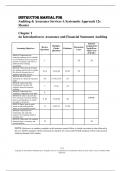Exam (elaborations)
Instructor Manual For Auditing & Assurance Services A Systematic Approach 12e Messier All Chapters
- Course
- Institution
- Book
Instructor Manual For Auditing & Assurance Services A Systematic Approach 12e Messier All Chapters
[Show more]



